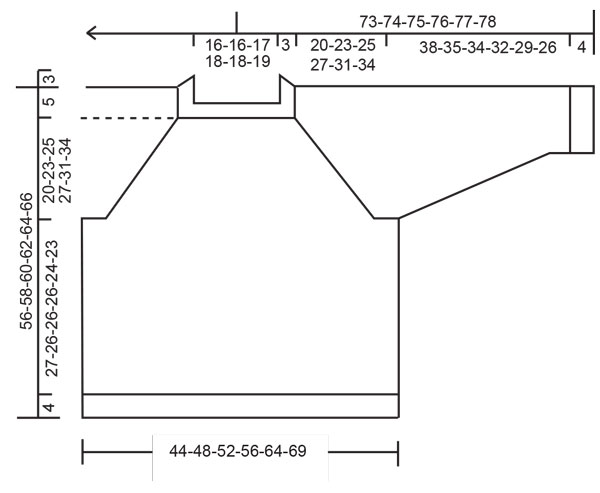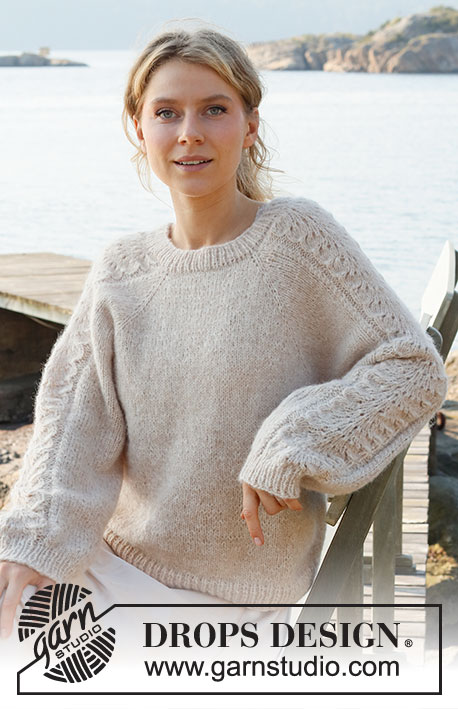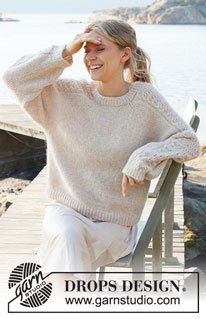Comments / Questions (175)
![]() Marine wrote:
Marine wrote:
Bonjour, J'ai quelques questions pour les manches : il faut relever les 6 en attente et commencer le tour au milieu de ces mailles. Cela signifie que si on tricote en circulaire, on relève 3 mailles sur l'aiguille de droite et 3 sur l'aiguille de gauche ? Pour les diminutions, doit-on ignorer les points notés sur A2 si on est au rang 5 du diagramme par exemple et faire les diminutions telles qu'elles sont expliquées ? Cela ne va pas altérer le motif ? Merci par avance !
26.10.2021 - 08:44DROPS Design answered:
Bonjour Marine. Quant a la premiere question - comment relever 6 mailles sous la manche regardez la video ICI. Ensuite vous placez 1 marqueur au milieu (entre les mailles, vous avez alors 3 mailles de chaque cote du marqueur). Les diminutions sous la manche n’affecterons pas le diagramme A.2, vous le tricotez comme avant. Bon tricot!
26.10.2021 - 17:10
![]() Natalia Stiro wrote:
Natalia Stiro wrote:
Una consulta. Luego de A1 tengo 126 puntos para el talle M. Si sigo con A2 y aumento 25 veces los 2 punto a cada lado del marcador tengo un aumento de 8 puntos por vuelta. Si son 25 veces los aumentos voy a terminar aumentando 200 puntos. Lo que hace que mí total luego de esa cantidad de aumentos es 326 y no 302 como marca el patrón. ¿Que estoy haciendo mal?
24.10.2021 - 23:29DROPS Design answered:
Hola Natalia, tienes 94 puntos, despues ‘Trabajar en punto jersey sobre los puntos en el delantero y la espalda, y A.1 (= 21 puntos) sobre los puntos en cada manga, AL MISMO TIEMPO en la 1ª vuelta comenzar aumentando para el RAGLÁN en cada transición entre el cuerpo y las mangas .. y hacer los aumentos para raglan 25 veces en total a cada lado de los 4 puntos con marcapuntos’. 94 + 8 (puntos aumentados en A.1) + (25x8) = 302 puntos. Sadudos!
25.10.2021 - 11:28
![]() Lallot wrote:
Lallot wrote:
Bonjour, j'ai des difficultés avec la lecture du diagramme A.1. je sais lire un diagramme mais ce sont les augmentations sur le côté qui me bloquent. rang 1 est bon mais pas le 2ème, les augmentations ne sont pas tricotées et donc je ne peux pas commencer par les 2 mailles endroits sur la ligne 2 du diagramme A1 par exemple!!!! est ce que le diagramme représente r1, r3, r5....? on fait rang 1 puis un rang endroit puis rang 3? merci pour votre réponse
22.10.2021 - 20:48DROPS Design answered:
Bonjour Mame Lallot, le diagramme represente tous les rangs. Quand on tricote le diagramme en rond, tous les tours se tricotent sur l'endroit, et le diagramme se lit uniquement sur l'endroit, le diagramme va ainsi se lire uniquement de droite à gauche. Quand on commence un nouveau tour, on commence simplement de nouveau au premier symbole du rang suivant du diagramme. Regardez la lecon drops sur ce sujet ICI. Bon tricot!
25.10.2021 - 12:56
![]() Kirsten Røine wrote:
Kirsten Røine wrote:
Sitter og strikker Bronze summer Sweater ,mønster nr 221-3, lurer på når jeg har strikketA1 og videre A2, skal jeg da starte opp på første pinne i A1 , eller hvor skal jeg starte opp igjen, Jeg har jo flere masker i mønsterrapporten etter å ha strikket A2? håper på rask svar , da dette er en gave, Mvh Kirsten Røine
06.10.2021 - 08:40DROPS Design answered:
Hej Kirsten. När du stickat A.1 och A.2 så upprepar du A.2 vidare (A.1 stickas alltså bara 1 gång precis i början). Mvh DROPS Design
06.10.2021 - 11:42
![]() Elisabet Cullbrand wrote:
Elisabet Cullbrand wrote:
Hur är svårighetsgraden på denna tröja.
01.10.2021 - 05:04DROPS Design answered:
Hej Elisabet. Den är medel skulle jag säga. Har man stickat lite tidigare så ska denna inte vara några problem att göra. Mvh DROPS Design
01.10.2021 - 09:55
![]() Gosia wrote:
Gosia wrote:
I tak większość do sprucia :( a tak się cieszyłam, że tą nudną część mam za sobą i zostają rękawy ze wzorem do dziergania! Jeszcze raz dziękuję za pomoc! Pozdrawiam!
16.09.2021 - 15:13DROPS Design answered:
Nie ma za co. Pochwal się jak skończysz, albo na grupie na facebooku DROPS Workshop, albo dodaj zdjęcie do galerii dropsfan na naszej stronie. Pozdrawiamy!
16.09.2021 - 15:32
![]() Gosia wrote:
Gosia wrote:
Dziękuję! spróbuje tak zrobić :) Teraz sobie myślę, że mogłam nie wydłużać robótki na wysokości reglanu robiąc rzędy bez dodawania oczek tylko dodawać oczka na reglan co 2 rzędy aż osiągnęłabym odpowiednią wysokość (czyli u mnie jakieś 8 dodatkowych rzędów). Wtedy sweter byłby szerszy a podkrój na odpowiednim miejscu? Czy dobrze myślę?
16.09.2021 - 15:02DROPS Design answered:
Masz rację. Ale tu musisz trochę popruć :)
16.09.2021 - 15:09
![]() Gosia wrote:
Gosia wrote:
Oczywiście robię próbkę i ją piorę. Nawet zadawałam tu pytanie co zrobić jeśli wysokość mojej próbki się nie zgadza i zgodnie z zaleceniem dodawałam kolejne rzędy bez dodawania oczek na reglanie :) Mierzyłam też swetry ale włóczka air jest puchata i jednak zabiera trochę miejsca z obwodu. To jest mój drugi sweter (przed tym zrobiłam dla córeczki jeden i jedną czapkę, to całe moje doświadczenie :)). Chciałabym go poprawić ale nie wiem jak :(
16.09.2021 - 14:44DROPS Design answered:
Witaj :) Jak góra, rękawy i dół rękawa jest ok, ja spróbowałabym równomiernie dodać trochę oczek na tyle i przodzie za reglanami i jeszcze raz za kilka rzędów (żeby nie było za dużo w jednym rzędzie bo się zrobi bombka). Po dodaniu oczek i przerobieniu kilku rzędów przełóż robótkę na 2 druty z żyłką, załóż na siebie i sprawdź czy będzie ok. Doświadczenie przyjdzie z czasem, nie zniechęcaj się. Pozdrawiam
16.09.2021 - 14:56
![]() Gosia wrote:
Gosia wrote:
Muszę coś w nim zmienić bo jest zbyt dopasowany i w takim nie będę chodziła więc szkoda marnować włóczkę :)Potrafię sobie wyobrazić co się stanie, gdy dodam więcej oczek na reglanie ale nie wiem co wyjdzie, gdy dodam tylko pod pachami oczek zamiast 6 ok.20 oczek?Mam właśnie na sobie bluzę, która ma szerokość na dole ok. 53cm i podkrój jest nisko i jest to ok. Tylko jak się podnosi ręce do góry to się mocno podciąga :)Ale mimo to taki efekt na swetrze bym chciała.
16.09.2021 - 13:55DROPS Design answered:
Witaj ponownie Gosiu, jak dodasz więcej oczek pod pachami, to będziesz miała szerszy obwód swetra i szersze rękawy (jeśli rękawy są ok, to możesz później zamknąć równomiernie nadmiar oczek pod spodem rękawa). Powodzenia!!!
16.09.2021 - 14:40
![]() Gosia wrote:
Gosia wrote:
Czy można mówić o dobrym pokroju rękawa jeśli sweter jest oversize? Przynajmniej na taki wyglądał na modelce dlatego postanowiłam go zrobić. Też mam 170cm i zazwyczaj nosze rozm. S. Mierząc teraz sweter wolałabym żeby miał szerokość z rozmiaru L czyli ok. 52-54 cm. Boję się, że dodawanie oczek za reglanami będzie widoczne bo jednak chce dodać ok 10 cm na szerokości. Mogłam od początku robić rozmiar L ale obawiałam się, że będzie bardzo szeroki na dekolcie.
16.09.2021 - 13:50DROPS Design answered:
Witaj Gosiu, przed rozpoczęciem pracy nad swetrem, najpierw biorę jakiś stary sweter, którego wymiary mi odpowiadają (głównie szerokość, bo długość zawsze można dopasować) i dobieram rozmiar wzoru DROPS, który będę wykonywać (na dole pod wzorem jest taki schematyczny rysunek). Jak ustalę właściwy rozmiar to robię próbkę dotąd, aż będzie zgodna z próbką w opisie (najlepiej ją jeszcze uprać i wysuszyć). Wtedy mam pewność co do końcowych wymiarów swetra. Wiem, że jest trochę tych przygotowań, a już chce się działać :) ale warto. Nie stresuję się później, że mnóstwo wykonanej pracy może pójść w gwizdek. Pozdrawiam
16.09.2021 - 14:36
Bronze Summer Sweater#bronzesummersweater |
|||||||||||||||||||||||||
 |
 |
||||||||||||||||||||||||
Knitted jumper in DROPS Air. Piece is knitted top down with raglan and lace pattern on sleeves. Size: S - XXXL
DROPS 221-3 |
|||||||||||||||||||||||||
|
------------------------------------------------------- EXPLANATION FOR THE PATTERN: ------------------------------------------------------- PATTERN: See diagrams A.1 and A.2. RAGLAN: Increase 1 stitch on each side of 1 stitch in stocking stitch (stitch with marker) in every transition between body and sleeves (= 8 stitches increased on round). Increase 1 stitch by making 1 yarn over. On next round work yarn overs twisted to avoid holes. Then work the new stitches in stocking stitch. DECREASE TIP (applies to sleeves): Decrease 1 stitch on each side of marker thread as follows: Work until 3 stitches remain before marker thread and knit 2 together, knit 2 (marker thread is between these stitches), slip 1 stitch knitwise, knit 1, pass slipped stitch over stitch worked. CAST-OFF TIP: To avoid a tight cast-off edge you may use a larger needle size. If this also is too tight, work a 1 yarn over after approx. every 4th stitch while casting off (cast off yarn overs as regular stitches). ------------------------------------------------------- START THE PIECE HERE: ------------------------------------------------------- JUMPER - SHORT OVERVIEW OF THE PIECE: Work yoke in the round on circular needle from mid back, top down. AT THE SAME TIME increase for raglan. Now divide yoke for body and sleeves. Body is worked in the round on circular needle, top down. Work sleeves in the round on double pointed needles/short circular needle, top down. YOKE: Cast on 90-94-98-102-106-110 stitches on circular needle size 4 mm with Air. Knit 1 round. Work rib (= knit 1/purl 1) over all stitches for 3 cm. Switch to circular size 5 mm and insert 1 marker here, now measure piece from here. Insert 4 marker threads in piece as follows (without working the stitches): Count 11-12-13-14-15-16 stitches (= half back piece), insert 1 marker thread in next stitch, count 21 stitches (= sleeve), insert 1 marker thread in next stitch, count 22-24-26-28-30-32 stitches (= front piece), insert 1 marker thread in next stitch, count 21 stitches (= sleeve), insert 1 marker thread in next stitch, 11-12-13-14-15-16 stitches remain on row after last marker thread (= half back piece). Work in stocking stitch over stitches on front piece and on back piece, and A.1 (= 21 stitches) over stitches on each sleeve, AT THE SAME TIME on first round start increase for RAGLAN in every transition between body and sleeves – read explanation above. Continue increases for raglan every other round. When A.1 has been worked 1 time vertically there are 122-126-130-134-138-142 stitches on round. Continue with A.2 (= 25 stitches) over stitches in A.1 with stocking stitch over front piece and back piece, and continue with increase for raglan every other round until increase has been done 22-25-27-29-33-36 times in total on each side of the 4 stitches with marker threads = 274-302-322-342-378-406. REMEMBER THE KNITTING TENSION! After last increase in raglan work without increases until piece measures 20-23-25-27-31-34 cm from marker. Work next round as follows: Work the first 34-38-41-44-49-53 stitches (= half back piece), slip the next 69-75-79-83-91-97 stitches on a stitch holder for sleeve, cast on 6-6-6-8-10-12 new stitches on needle (= in the side under sleeve), work the next 68-76-82-88-98-106 stitches (= front piece), slip the next 69-75-79-83-91-97 stitches on a stitch holder (= sleeve), cast on 6-6-6-8-10-12 new stitches on needle (= in the side under sleeve), work the remaining 34-38-41-44-49-53 stitches (= half back piece). NOW MEASURE PIECE FROM HERE! BODY: = 148-164-176-192-216-236 stitches. Continue in stocking stitch until piece measures 27-26-26-26-24-23 cm from division. Switch to circular needle size 4 mm. Work rib (= purl 1/knit 1) over all stitches. Continue rib like this for 4 cm. Loosely cast off with knit over knit and purl over purl, read CAST-OFF TIP. Jumper measures approx. 56-58-60-62-64-66 cm from shoulder. SLEEVE: Slip the 69-75-79-83-91-97 stitches from stitch holder in one side of piece on a short circular needle/double pointed needles size 5 mm and pick in addition up 1 stitch in each of the 6-6-6-8-10-12 stitches cast on in the side under sleeve = 75-81-85-91-101-109 stitches. Insert 1 marker thread in the middle of the 6-6-6-8-10-12 stitches under sleeve and move the marker thread upwards when working, it is used for decrease later. Begin round at the marker thread and continue with A.2 and stocking stitch in the round. When piece measures 3 cm from division, decrease 2 stitches mid under sleeve - read DECREASE TIP. Decrease like this every 3½-3-2-1½-1-1 cm 10-11-13-16-19-21 times in total = 55-59-59-59-63-67 stitches. Continue until piece measures 38-35-34-32-29-26 cm from division - or desired length (shorter measurements in the larger sizes because of longer yoke). Work 1 round while decreasing 11 stitches evenly over stitches in A.2 = 44-48-48-48-52-56 stitches. Switch to double pointed needles size 4 mm and work rib in the round = knit 1/purl 1 for 4 cm. Cast off with knit over knit and purl over purl (to avoid a tight cast-off edge use double pointed needles size 4 mm). Work the other sleeve the same way. |
|||||||||||||||||||||||||
Diagram explanations |
|||||||||||||||||||||||||
|
|||||||||||||||||||||||||

|
|||||||||||||||||||||||||

|
|||||||||||||||||||||||||
Have you finished this pattern?Tag your pictures with #dropspattern #bronzesummersweater or submit them to the #dropsfan gallery. Do you need help with this pattern?You'll find 30 tutorial videos, a Comments/Questions area and more by visiting the pattern on garnstudio.com. © 1982-2025 DROPS Design A/S. We reserve all rights. This document, including all its sub-sections, has copyrights. Read more about what you can do with our patterns at the bottom of each pattern on our site. |
|||||||||||||||||||||||||

















































































Post a comment to pattern DROPS 221-3
We would love to hear what you have to say about this pattern!
If you want to leave a question, please make sure you select the correct category in the form below, to speed up the answering process. Required fields are marked *.